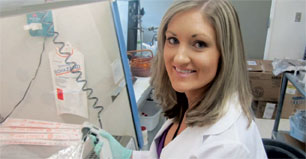Nanoscience and Microsystems Program (NSMS)

Carlee Asley in a Biosafety 2 lab at the Advanced Materials Laboratory, a building shared by UNM and Sandia Labs that has fostered numerous interdisciplinary research projects.
The industrial revolution of our time may be based on elements that are 50,000 times smaller than a human hair. Those nanoscale building blocks are the materials, structures, and machines of the future. When integrated into microsystems, the potential is limitless.
 The importance of nanoscience is growing rapidly and UNM is one of the few universities in the country to offer a degree in the discipline. “Those of us who have been researching nanomaterials felt that there was a need to attract students from outside our individual departments, so that’s why we needed an interdisciplinary program,” says Abhaya Datye, distinguished professor of chemical and nuclear engineering. “It’s important to have programs that rejuvenate graduate education.”
The importance of nanoscience is growing rapidly and UNM is one of the few universities in the country to offer a degree in the discipline. “Those of us who have been researching nanomaterials felt that there was a need to attract students from outside our individual departments, so that’s why we needed an interdisciplinary program,” says Abhaya Datye, distinguished professor of chemical and nuclear engineering. “It’s important to have programs that rejuvenate graduate education.”
The Nanoscience and Microsystems Program (NSMS) began as a joint effort between the SOE and the College of Arts and Sciences and started offering masters and doctoral degrees as well as a minor for doctoral students in 2007. Faculty from all SOE departments, as well as physics, chemistry, biology, mathematics, earth and planetary sciences, and the biomedical sciences are involved in teaching integrated courses that bridge science at the nanoscale with
microsystems technology. Currently over 70 students are enrolled and, to date, two PhDs, three MS majors, and five PhD minors have graduated from the program.
In fall 2010, the curriculum was expanded to include the Anderson School of Business and the Health Sciences Center. A new master’s degree includes courses from the business school and participation of students in the technology business plan competition. In October 2010, one of only six five-year Cancer Nanotechnology Training Center (CNTC) grants in the nation was awarded to UNM specifically support NSMS research focused on improving the diagnosis and treatment of cancer. Clinicians and biologists in the Health Sciences Center are teaming with SOE faculty to develop new courses that integrate key problems in cancer diagnosis and treatment.
The CNTC grant provides stipends for six graduate students and two postdoctoral fellows each year. A recent NSMS graduate, Carlee Ashley, was awarded one of two prestigious Harry S. Truman Fellowships in National Security Science and Engineering offered by Sandia National Laboratories for 2010-2013. As a post-doctoral fellow at Sandia’s Livermore, CA site, she’s researching how virus-like particles can be engineered for targeted delivery of therapeutic agents to cancer, pathogenic bacteria, and cells infected with viruses. She says her current research and early career successes are an extension of an interdisciplinary collaboration between Jeffrey Brinker, distinguished professor of chemical engineering, and David Peabody, professor of molecular genetics and microbiology, that was a direct result of the NSMS program.
“Had I not been involved in the NSMS program, I would have worked on a very different research project, and I probably wouldn’t have gotten the Truman Fellowship,” says Ashley.
